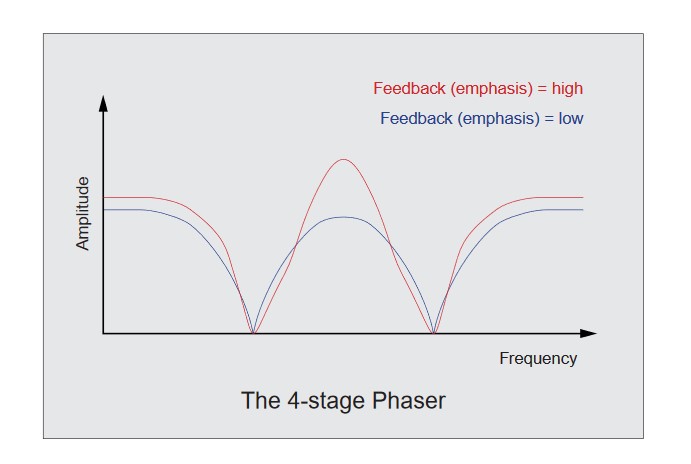Analogue Systems
Classic phase shifter design with V.C. of parameters and built in LFO which is available to the user on a socket.
No more available!
Phaser Shifters (or "phasers") were the most common 'effects' used throughout the 1970s, and have remained popular since. Their slow, evolving sweeps were a mainstay of rock keyboards,and were used extensively on sounds such as electric 12-stringguitars, where a faster modulation speed produced a sound akin to playing the instrument through a Leslie rotary speaker cabinet.
Phasers work by combining the input signal with a delayed(and therefore phase-shifted) version of itself. Where the shifted frequencies are in phase with the original signal, they reinforce any harmonics that lie at those frequencies. Where the shifted frequencies are out of phase with the original, they interfere destructively, and attenuate any harmonics that lie at those frequencies. If the amplitudes of the original and shifted signals are equal, there are notches in the output spectrum.
The number of notches is determined by the number of delay stages in a unit's architecture. One design employs four stages that shift the phase of the input signal from 0º at low frequencies to 720º at high frequencies. This means that the original and shifted signals reinforce at low and high frequencies, and also at 360º, with two regions of cancellation at 180º and 540º. We can conclude, therefore, that the number of notches in the output is equal to half the number of phase-shifting stages in the device. The figure overleaf may make this clearer.
Some vintage phasers use more stages to create higher numbers of troughs and peaks. However, increasing the number of stages does not necessarily create a more pleasing effect, and in some circumstances the results can be too subtle to be of use.
Many phasers have a positive feedback loop that sharpens and emphasises the peaks between the notches. Increasing the feedback signal makes these peaks progressively sharper until - in extreme cases - the phaser begins to oscillate. The Electro-Harmonix Small Stone offered a switch that offered two levels of feedback, but some owners modified their units to allow them to determine the amount of emphasis using a knob. These modified units became the sonic benchmark for the design of the RS-400.
The classic phaser effect is generated by sweeping the frequencies at which the notches occur. This creates a complex spectral response that is not easily duplicated using conventional filters. To this end, all stand-alone phasers incorporate an LFO with a frequency range of a few percent of a Hertz to 10Hz or there abouts. For a given number of stages it is the speed and depth of this LFO that determine the nature of the output.
More sophisticated phasers also offer CV inputs that allow you to affect or even replace the LFO modulation. This makes it possible to produce a further range of 'phasey' sounds that do not display the more common cyclic characteristic.
The RS-400 is a 4-stage phaser with an integrated LFO and CV inputs to control the notch frequencies. It offers variable resonance to create a wide range of phase-shifting effects.
FREQUENCY
If no modulation is applied, the FREQUENCY knob determines the positions of the notches. With modulation applied, it defines the notch frequencies when all modulating CVs sum to 0V.
• FREQUENCY = LOW
- Lower notch = 20Hz
- Upper notch = 120Hz
• FREQUENCY = HIGH
- Lower notch = 7.5kHz
- Upper notch = 45kHz
EMPHASIS
This determines the amount of output signal fed back to the phaser input, and emphasises the peak of the spectrum between the notches.
• RESONANCE = MIN
No feedback occurs
• RESONANCE = MAX
High level positive feedback occurs.
The RS-400 is calibrated such that the emphasis stops just short of self-oscillation.
LFO DEPTH and RATE
The LFO is patched internally to the FREQUENCY of the phase shifters. An applied CV of 1V doubles the FREQUENCY. Likewise, an applied CV of -1V halves the FREQUENCY. This makes it possible to sweep the notches from subsonic to supersonic frequencies.
Waveform: Triangle wave
Frequency range: Approximately 0.2Hz to 10Hz.
Maximum depth: ±5V
Inputs and Outputs
The RS-400 offers an audio signal input, an audio signal output, two CV inputs, and a CV output:
SIG IN
Accepts audio signals in the range ±10V
SIG OUT
Outputs audio signals in the range ±10VCV
IN VARY and LEVEL
Accepts CVs in the range ±10V. You may attenuate any CV presented to the CV-IN VARY input using the associated LEVEL control. The resulting voltage is summed with the internally patched LFO and any CV applied at the CV-IN FIXED input.
CV IN FIXED
Accepts CVs in the range ±10V. There is no associated attenuator. The voltage is summed with the internally patched LFO and any attenuated (or not) CV applied at the CV-IN VARY input.
LFO OUT
You may tap the output from the RS-400 LFO and direct it to any suitable destination within your RS Integrator.
APPROXIMATE RESPONSE OF THE RS-400


